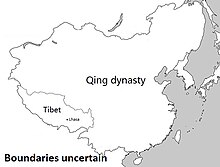
Back التبت تحت حكم سلالة تشينغ Arabic Tibet under Qing rule English Tíbet durante la dinastía Qing Spanish Tibet sous la tutelle des Qing French Tibet di bawah kekuasaan Qing ID 청나라 치하 티베트 Korean Tibete sob o domínio Qing Portuguese Tibet dina Kakawasaan Qing Sundanese குயிங் ஆட்சியில் திபெத் Tamil Тибет у Новий час (1642-1912) Ukrainian
| Tibet di bawah pemerintahan Qing | |||||||||
|---|---|---|---|---|---|---|---|---|---|
| di bawah pemerintahan di Dinasti Qing | |||||||||
| 1720–1912 | |||||||||
 Tibet dalam Dinasti Qing pada 1820. | |||||||||
| Ibu kota | Lhasa | ||||||||
| History | |||||||||
| • Jenis | Hierarki Qing dan Kashag | ||||||||
| Sejarah | |||||||||
| 1720 | |||||||||
| 1912 | |||||||||
| |||||||||
Paparan amaran: Page using Template:Infobox former subdivision with unknown parameter "year_event1"
Paparan amaran: Page using Template:Infobox former subdivision with unknown parameter "year_event3"
Paparan amaran: Page using Template:Infobox former subdivision with unknown parameter "continent"
Paparan amaran: Page using Template:Infobox former subdivision with unknown parameter "empire"
Paparan amaran: Page using Template:Infobox former subdivision with unknown parameter "region"
Paparan amaran: Page using Template:Infobox former subdivision with unknown parameter "religion"
Paparan amaran: Page using Template:Infobox former subdivision with unknown parameter "status"
Paparan amaran: Page using Template:Infobox former subdivision with unknown parameter "year_event2"
Tibet di bawah pemerintahan Qing[1][2] merujuk kepada hubungan dinasti Qing dengan Tibet dari 1720 hingga 1912.[3][4][5] Dalam tempoh ini, Qing China menganggap Tibet sebagai sebuah negara vasal.[6] Tibet menganggap diri sendiri sebuah negara merdeka yang hanya mempunyai hubungan "pendeta dan penaung" dengan Dinasti Qing.[7][8][9][10] Ulama seperti Melvyn Goldstein telah menganggap Tibet sebagai negeri naungan Qing.[11]
- ^ Dabringhaus, Sabine (2014), "The Ambans of Tibet—Imperial Rule at the Inner Asian Periphery", dalam Dabringhaus, Sabine; Duindam, Jeroen (penyunting), The Dynastic Centre and the Provinces, Agents and Interactions, Brill, m/s. 114–126, doi:10.1163/9789004272095_008, ISBN 9789004272095, JSTOR 10.1163/j.ctt1w8h2x3.12
- ^ Di Cosmo, Nicola (2009), "The Qing and Inner Asia: 1636–1800", dalam Nicola Di Cosmo; Allen J. Frank; Peter B. Golden (penyunting), The Cambridge History of Inner Asia: The Chinggisid Age, Cambridge University Press
- ^ Szczepanski, Kallie (31 May 2018). "Was Tibet Always Part of China?". ThoughtCo.
- ^ Lamb 1989: "From the outset, it became apparent that a major problem lay in the nature of Tibet's international status.
- ^ Sperling 2004: "The status of Tibet is at the core of the dispute, as it has been for all parties drawn into it over the past century.
- ^ Sperling 2004.
- ^ Mehra 1974: The statement of Tibetan claims at the 1914 Simla Conference read: "Tibet and China have never been under each other and will never associate with each other in future.
- ^ Szczepanski, Kallie (31 May 2018). "Was Tibet Always Part of China?". ThoughtCo.
- ^ Tsering Shakya, "The Thirteenth Dalai Lama, Tubten Gyatso" Treasury of Lives, accessed May 11, 2021.
- ^ Fitzherbert & Travers 2020: '[From 1642], as a Buddhist government, the Ganden Phodrang’s choice to relinquish... the military defence of its territory to foreign troops, first Mongol and later Sino-Manchu, in the framework of “patron-preceptor” (mchod yon) relationships, created a structural situation involving long-term contacts and cooperation between Tibetans and "foreign" military cultures.'
- ^ Goldstein, Melvyn C. (April 1995), Tibet, China and the United States (PDF), The Atlantic Council